699 Search Results for communication book
August 11, 2015
by Carole Zangari -
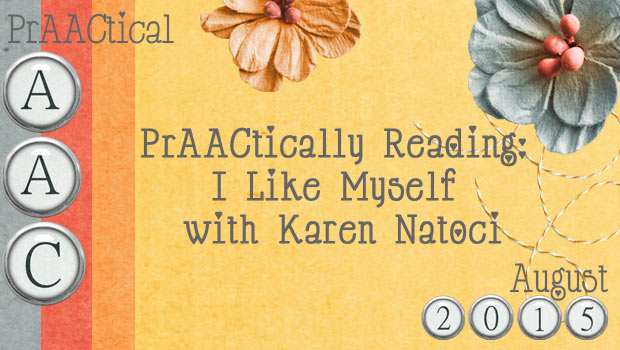
Karen Natoci is back with some wonderful ideas for building AAC skills using the book, I Like Myself. Check out her lesson plan and suggestions for some prAACtical reading ::::::::::::::::::::::: Book: I Like Myself!, by Karen Beaumont; Illustrated by David Catrow (Scholastic Inc.) Core Vocabulary focus: I, WANT, LIKE, ME/MY, SAME, DIFFERENT, GO, IN, DO, Fringe Vocabulary focus- Body Parts: eyes, ears, nose, fingers, toes, head, Opposites Vocabulary use: wild/tame, fast/slow, Core Vocabulary focus: I, LIKE, ME/MY, Fringe Vocabulary focus- Abstract VERBS: Think, say, COMMUNICATION Matrix (Rowland, 2009) Level: I-VII ——————————————————————– School is just around the corner and the planning begins! Our school year started in mid July. During the first two weeks, we decided to focus on the shared reading of: I Like Myself! by Karen Beaumont. This book is thoughtful, has great rhyme and rhythm, and is illustrated beautifully. It is a great way to think about the... [Read More...]
August 6, 2015
by Carole Zangari -
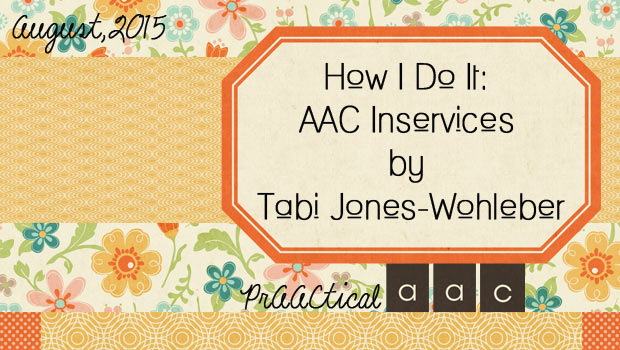
Many SLPs involved in AAC service provision are called upon to provide inservice training on implementation strategies. In this post, we are very fortunate to have Tabi Jones-Wohleber back to share both her thoughts and training materials. Tabi, an SLP on the AT Team for Frederick County Public Schools in Maryland, wrote two previous posts for us. In those posts, Tabi shared her All-in-One Visual Support Tool and Classroom CORE Tool. Today, we hear about her experiences with professional development for teachers, aides, and therapists who serve students with AAC needs. ::::::::::::::::::::::::::::::::::::::::::::::::::::::::: Implementing AAC: A Picture…AND…A Purpose As I work with staff and students to support implementation of AAC, I’ve learned 2 important things about making it work: 1) Folks need to know what it looks like “in their classroom/life” AND 2) effective implementation does not emerge from directives, but rather evolves from understanding, engagement and ownership of the WHAT... [Read More...]
July 16, 2015
by Carole Zangari -
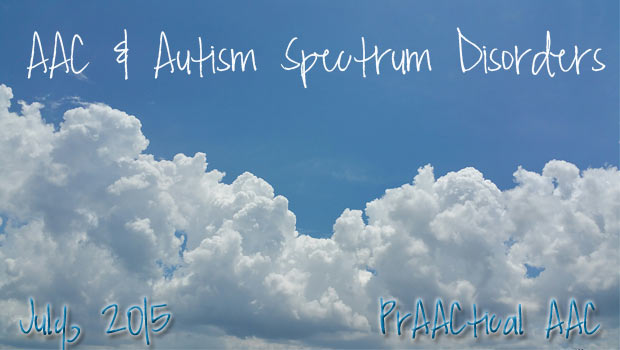
In Robin’s honor, we revisit some of her most popular posts. Please share them with people who might find them helpful. Beyond Requesting: Let’s Chat with Peers Begin AAC Now: 10 Things to Do AAC Must-Have’s for the Classroom and Therapy Room The First 12: Getting Started with Core Words Literacy For Everyone with Adapted Books Beyond Requesting: Using Scripts to Teach Conversation AAC Goals That Matter Creating Communication Boards: There are Lot of Apps for That! Join Together: Core and Fringe Vocabulary 30 Ways to Celebrate Autism Awareness Month
June 21, 2015
by Carole Zangari -
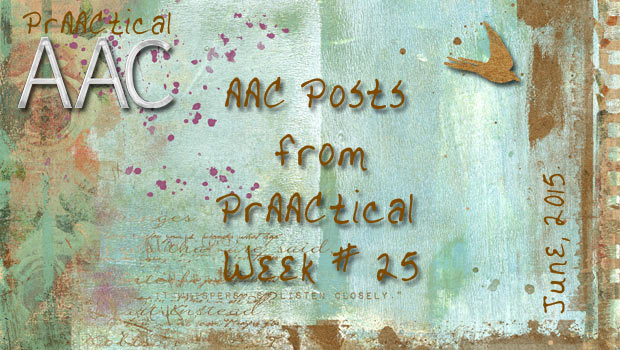
Monday – How I Do It: Classroom CORE Book by Tabi Jones-Wohleber Tuesday – “What’s Wrong?” AAC Messages for Negative Emotions and Feelings Wednesday – Video of the Week: Communication Through Eye Pointing Thursday – Site of the Month: Miami Dade County PreKindergarten Program for Children with Disabilities
June 18, 2015
by Carole Zangari -
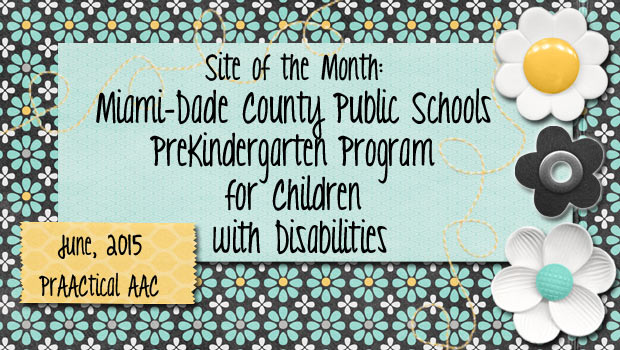
These days, there are so many wonderful websites for resources and AAC-related information that sometimes it is hard to remember where to look. When I decided to feature some of my favorite sites, I wanted to start with a site that has been helping SLPs, teachers, and families for a long time. The website for preschool special education program at Miami Dade County Public Schools has been a ‘go-to’ resources for many years. The AT team, which serves over 200 preK classrooms, has evolved over the years, but what has not changed is their commitment to helping children learn to communicate. If you work with little ones, you may want to spend some time exploring their site. Here are some of the AAC-related highlights to get you started. Implementing AAC in the Preschool Classroom Using the daily routine as a framework Motivating messages Modeling AAC Using cues and wait time Using... [Read More...]
June 11, 2015
by Carole Zangari -
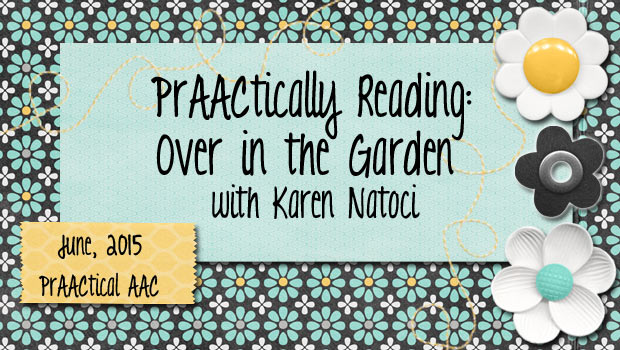
Karen Natoci is back with another wonderful book and plenty of ideas for AAC implementation. Enjoy! Book: Over in the Garden, by Jennifer Ward, Illustrated by Kenneth J. Spengler Core Vocabulary focus: LOOK, IT, LIKE, NOT LIKE, IN, UH-OH OR OOPS. Literacy Level: Emergent COMMUNICATION Matrix Level: I-VII Four Block focus: Shared Reading and Working with Words (at the alphabet/rhyme level) —————————————————— It is spring at our school in Michigan and everything is green and the plants are beginning to grow, fast! I couldn’t wait to share my favorite book to sing: Over in the Garden! We found the nearest plant, gathered a few plastic bugs, adapted the book with some cut out fringe words (each type of bug) and I sang into the microphone! I decided to sing the book and play with sustaining certain words as you will see in this very short video. The rhythm, rhyme and... [Read More...]
June 8, 2015
by Carole Zangari -
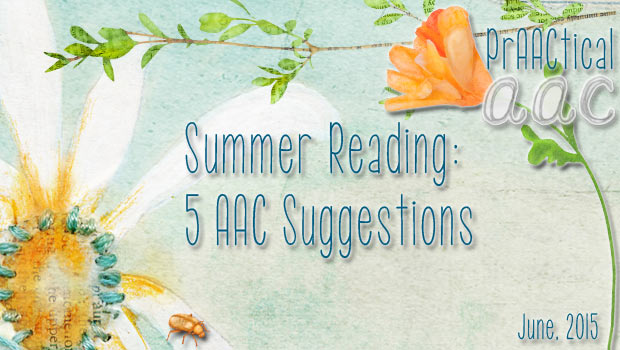
It is sunny and hot where we live, and we’re honoring the tradition of using beach and pool time to catch up on some of the books and articles that have been piling up throughout the year. Are you looking for summer reading material that goes beyond magazines and light fiction? Here are a few AAC selections to round out your summer reading list. The Impact of IQ on Using High-tech Augmentative Alternative Communication AAC in Children with Autism Spectrum Disorder by Drs. Rana Zeina, Laila Al-Ayadhi, and Shahid Bashir AAC in the Schools: Best Practices for Intervention by Drs. Nancy Robinson and Gloria Soto Aided Augmentative Communication for Individuals with Autism Spectrum Disorder by Dr. Jennifer Ganz Critical Issues Using Brain-Computer Interfaces for Augmentative and Alternative Communication by Dr. Katya Hill, Mr. Thomas Kovacs, and Sangeun Shin Real-Life Challenges in Using Augmentative and Alternative Communication by Persons With Amyotrophic Lateral... [Read More...]
June 2, 2015
by Carole Zangari -

Jill Senner and Matthew Baud are back to share some of their favorite therapy activities. In this post, they discuss how they build language while making ice cream. Summer is almost here and we’re already thinking about making our favorite frozen treat, ice cream in a bag. No special equipment is required. With a couple of plastic zipper bags and 5 ingredients already in your kitchen, kids can shake milk into ice cream in just 5 minutes. Free picture recipes can be downloaded here. As with many of the cooking activities we love, there are lots of natural opportunities for language use before, during and after cooking. Before cooking we read the recipe and check the kitchen to see if we have the ingredients. If any are missing, we write shopping lists of ingredients we need. We can take a community field trip to the grocery store where there... [Read More...]
May 14, 2015
by Carole Zangari -
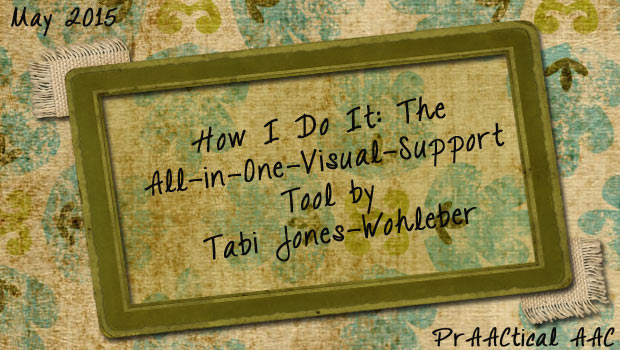
I am constantly in awe of the creativity and generosity of AAC practitioners, particularly those like Tabi Jones-Wohleber who make fabulous materials and share them with colleagues that they’ve never even met. Tabi is an SLP on the AT Team for Frederick County Public Schools in Maryland. A graduate of Penn State University, her career has focused on AAC. Though she works with many schools and addresses a variety of AT needs, most of her time and creative energy is devoted to working with students with the most significant disabilities. In this post, she introduces us to the All-in-One-Visual-Support Tool. You wont want to miss Tabi’s treasure trove of prAACtical materials. :::::::::::::::::::::::::::::::::::::::::::::::::::::::::::::::::::::::::::::::::::: It was a conversation I’d had many times before. A conversation that kept resurfacing in one form or another. It’s the conversation of how to manage all the stuff; all the visuals, all the reinforcers, all the communication tools. The benefit of visual supports to... [Read More...]
May 7, 2015
by Carole Zangari -

Who doesn’t love reading books by Theodor Seuss Guisel? Michigan-based SLP Karen Natoci is back to show us how she is using one of his most beloved books to integrate language and literacy instruction with the AAC learners in some of the classrooms she serves. Be sure to download her lesson plan and watch the video clip of Karen in AACtion. Enjoy! :::::::::::::::::::::::::::::::::::::::::::::::::::::::::::::::::::::::::::::: CLASSIC Book: The CAT in the HAT, by Dr. Seuss Core Vocabulary focus: LOOK, NOT, LIKE, NOT LIKE, NO, GO, DO, UH-OH or OOPS. COMMUNICATION Matrix Level: I-VII Four Block focus: Shared Reading and Working with Words (at the alphabet/rhyme level) ————————————————————————————————————————————- It is Spirit Week at our school and Monday is Hat DAY!! What better excuse to read, The Cat in the Hat!! The rhythm of the reading along with the site of all of our wacky hats made for a fun morning in room 8!... [Read More...]









